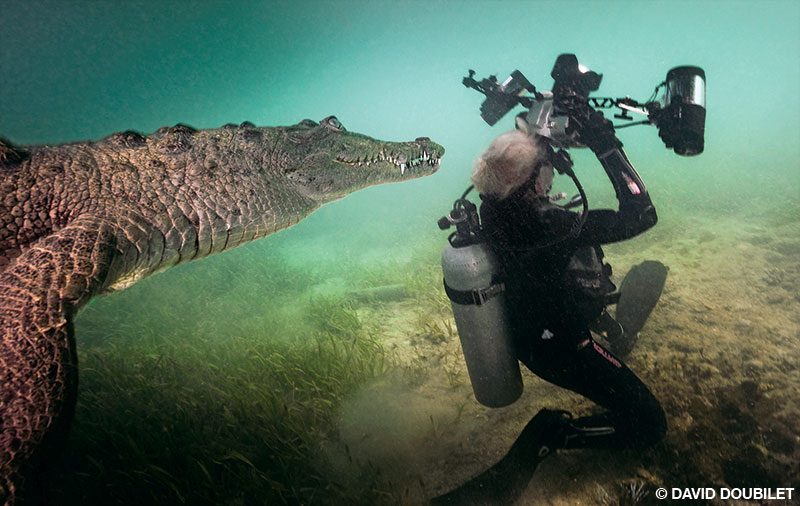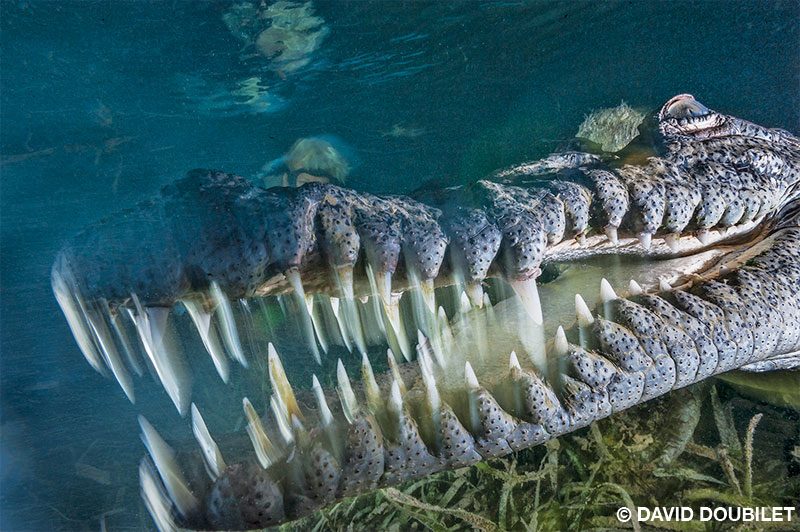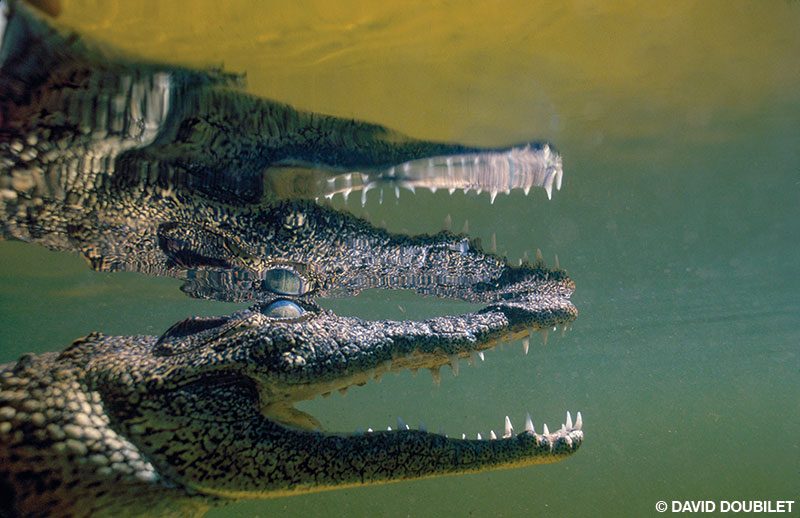Permettez-moi de l'affirmer sans équivoque : Les crocodiles sont des prédateurs de premier ordre et, au mauvais endroit et au mauvais moment, les humains sont des proies potentielles. Il y a des exceptions, mais la plupart de ces merveilleux reptiles primitifs n'hésitent pas à rencontrer un repas potentiel. Lorsque vous nagez dans un habitat de reptiles, sachez qui et quoi vous risquez de rencontrer, ou ne nagez pas du tout.
David Doubilet and I were on a National Geographic assignment in Cuba’s Jardines de la Reina (Gardens of the Queen) National Park. We had eight short shooting days to capture the magic of the long-ago Caribbean in this marine museum. With a “HEY!” noise through his regulator, David interrupted my obsession with a jelly floating above me. He swam toward me and fired off a series of strobe bursts that needed no interpretation.
I turned to find myself face to snout with an American crocodile. Greeting my unaggressive reptile visitor, I gave David a thumbs-up, burbled, “Hello, handsome! Look at you!” and captured its portrait. After a few frames, it was unimpressed with me and drifted downstream to do other crocodile things, and I returned to my jellyfish.

When some people see David’s image of the crocodile inches behind me, their reactions include wonder, awe, anger, horror and “How could he?!” — how could her husband take a picture and not save her? My answer is this: David gave the appropriate warning and quickly swam to me. I was a visitor in this creature’s environment, and in this circumstance there were more knowns than unknowns, so I did not feel threatened.
Les crocodiles américains résidents (Crocodylus acutus) at Jardines de la Reina routinely share their waters with snorkelers and divers. I was fortunate to have an encounter with this symbol of an intact ecosystem that supports apex predators, and the image is an opportunity to discuss marine conservation. As journalists, we are careful never to suggest crocodiles are safe to swim with or let our images appear with sensational headlines that promote fear and loathing of marine life — and we have had many such requests.
Je n'ai pas ressenti le même confort en travaillant sur le crocodile du Nil (Crocodylus niloticus) waters in Botswana’s Okavango Delta a decade earlier for a story called “Miracle Delta.” The story idea developed over a scotch in Washington when fellow wildlife photographer Frans Lanting remarked, “There is clear water for one month in the Okavango, and no one has looked closely beneath the surface there.” With unexplored places, there is always a reason why. In this case, there were two reasons: hippos and Nile crocodiles.
We were diving at Okavango Panhandle with our guides, Brad Bestelink and Andy Crawford, who taught us that large crocs sense your vibrations in the water and move in, hoping to find a new wildlife crossing. Keeping this in mind, we never dived the same place twice and never stayed for more than two hours. While we were photographing in a lily and papyrus garden that looked from below like a Monet painting, Brad signaled that our time was up. David responded with the familiar photographer’s plea for a little more time, just one more shot. Brad steeled his voice and said, “Out means out, David.” We pouted and moved well downstream to another spot.

Hours later, David asked to go back to the magical place for a night shot. Brad agreed, and we boated through the dark with spotlights on the bow. As we turned the bend, I exclaimed, “Holy hippo!” A giant hippo stood right where we had been working. Brad handed me his light, and we were astonished to see that the large figure was no hippo. A Nile crocodile more than 14 feet long had claimed the spot where we wanted to jump in. It was a very quiet ride back to the dock. Back in our lean-to, I not-so-calmly asked David, “What are we doing here? What were we thinking?”
Fast forward a few weeks, and we were armed with growing confidence, a local Shaman ceremony (for men only) to protect David from crocodiles and what must have been a glaring memory lapse. We learned about crocodile lairs beneath the papyrus mats — underwater hollows where crocodiles sleep. Our safe plan was to explore one at midday when the crocs were sunning themselves on the bank. The team swam into the chamber to find a white sand bottom, dark papyrus-root roof and meter-wide tunnels leading who knows where. I lit the chamber while David photographed the reptile living room, where dozens of croc prints half the size of my fin crisscrossed the floor. There were many places I would rather be than staring down the dark tunnel in front of me, so I signaled David to hurry.
Quelques nuits plus tard, autour du feu de camp, un ichtyologiste de passage nous a parlé du poisson-chat du Zambèze. Le poisson-chat du haut Zambèze (Synodontis woosnami), une espèce de poisson-chat renversé originaire du Botswana, est jaune vif avec des pois noirs et ne sort que la nuit. Sentant que notre histoire de l'Okavango serait en quelque sorte incomplète sans lui, nous avons planifié une plongée de nuit dans le canal de Nxamasere pour documenter cette merveille du monde de l'eau douce africaine.
Nous avons élaboré notre plan d'intervention, qui commençait par une excursion en bateau jusqu'au canal qui se jette dans la rivière Okavango. Les trois équipes seraient notre équipe de bateau (un conducteur, un projecteur et un carabinier) et deux équipes de plongeurs : David avec Brad et moi avec Andy. Les guides nous guideraient et seraient entièrement responsables de la plongée, sans aucune exception.
Gearing up with an extra light, Brad also demonstrated the “croc stoppers” that each guide would carry. “It’s just a pointed stick,” I remarked, wondering how it would be useful against a crocodile. Brad replied, “If you see a croc, use it to kill yourself.” “Understood,” I answered. Our final instructions were to never swim near the edge of or underneath the papyrus under any circumstance and immediately surface if we heard gunshots, banging or the boat engine revving. We also had to beware of drifting too fast and getting swept into the main river — the boat team wouldn’t know it had happened, but the crocs would.

David and Brad rolled into the dark water first and disappeared quickly, and I momentarily thought, “He’s the National Geographic talent and had the anti-croc ceremony. Do I really need to go?” Conscience and curiosity took over as Andy and I did a giant stride through the Botswana night into the river.
Andy’s light made a pitifully small circle on the bottom. We sorted ourselves out, I pointed down my strobe arms, and we began to explore. A carpet of what looked like Vermont fall leaves littered the bottom. We drifted slowly, pulling away layers to expose the bottom, finally revealing yellow whiskers and a body with black spots. Here was the reason for being where we were and where we should not have been. Andy staked the croc stick in the sand, and we used it to brace ourselves in the current. I shot several frames before the squeaker swam off. We followed but quickly lost it.
Pour nous repérer, nous avons braqué la lumière vers le haut pour découvrir un tapis de papyrus au-dessus de nous. Nous étions dans le salon d'un crocodile plein d'empreintes. Andy a braqué la lumière sur le visage de la jeune femme, lui a fait un geste de tranchant sur la gorge et a commencé à nager vers l'arrière. Nous venions de sortir de la chambre lorsque nous avons entendu les moteurs tourner sans arrêt et le bruit inimitable du métal qui frappe le métal. Nous avons rempli nos compensateurs de flottabilité et avons remonté les trois mètres qui nous séparaient de la surface.
I managed to blurt out, “What is…” as the boat team pulled us up by our hoods and hair, no ladder involved and without explanation or apology. Brad and David were already on board. We had drifted too fast and were yards from entering the river. The boat spotlight revealed many sets of blazing red eyes on the bank at the end of the Nxamasere Channel, right where we would have ended up.
Heureusement, nous avons obtenu ce que nous voulions sans incident et nous avons réussi à publier nos photos du Zambezi squeaker. Le delta de l'Okavango est un lieu magique, rempli de rêves et de dangers. Il ne devrait jamais être considéré comme une destination de plongée, mais économisez votre argent et envisagez d'y faire un safari. Il vous touchera au plus profond de votre âme.
© Alert Diver — Q1 2021